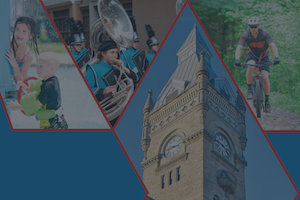A Historical Tour of Marion Township, Boyers
A million years ago, ice covered a portion of Pennsylvania, including what is today known as Marion Township. The glaciers melted and retreated, leaving many deposits behind. The deposits were abundant, but of special interest were the deposits of limestone and coal, which set the stage for the development and growth of Marion Township.
The first settlers arrived in the township around the 1800, no doubt following Indian trails. Marion Township lacks the broad rivers of Pittsburgh or Oil City, so settlers had to hike into the area or use horses to transverse the land.
One of the first settlers to do so was an Irish immigrant, Hugh Murrin, who settled in northern Marion Township. A small village grew around the crossroads of present-day Route 308 and Route 58. The village was named Murrinsville and consisted of a number of homes and two grocery stores, McBride’s and Gormely.
The area is still known as Murrinsville, but there are no indications of a village with the exception of St. Alphonse Roman Catholic Church and the adjacent property and cemetery. A group of local residents are working today to transform the church property into a community center.
Traveling West on Route 58, you would pass through Bowsertown. You can see West Unity Community Church on your right. Moving west, you would encounter Allegheny Minerals’ open pit limestone mine, Cherie Pierce Family Hair Care and the most unique spot in Marion Township: Yogi Bear Jellystone Campground at Kozy Rest.
Leaving Murrinsville traveling down Route 308 South, we enter the town of Boyers.
A small town grew around Annadale Station after the train came into this part of Marion Township starting in 1876. The original name of the town was Byerstown after an early settler of German descent, F. (or R.) Byers, but the post office somehow registered as Boyers. Two hotels, a wagon and blacksmith shop and a grist mill were built.
In 1907, the Pittsburgh Limestone Corporation began a deep mine operation on a large, deep seam of limestone to be used in the steel mills of Pittsburgh. This mine became part of Michigan Limestone Eastern district and would much later be the basis for the Iron Mountain Facility today.
To accommodate its many workers, Michigan Limestone built duplex housing on Clay Street. There was one plan utilized for all the homes. It became known as “The Company Block.”
The homes were then rented to the mine workers. The daily upkeep on these homes was up to the renters, but if you wanted a room painted, you completed a form and upon approval the company painter would arrive and paint your rooms. The town was becoming the quintessential company town.
The company now built and supplied a store, the Union Supply. The first section was grocery, the second section was dry goods, the third section was furniture and the last section was a gas station. Everything you needed could be purchased at the company store—but when you went to the store office, everything you had purchased for the week was deducted from your paycheck. This building now houses McBride’s Pizza and the township office.
The late 1940s and 1950s were the prime period of the limestone mine. The town was filled with workers who all knew each other and had a family feel. People looked after and helped their neighbors. It also was the period TV came to town. A few people had TVs at first. The picture was black and white and there were three channels. At midnight, TV ended for the day.
It was also the era of the party line. The telephone line was shared with at least eight to 10 neighbors. You never started to dial until you determined the line was not in use. Some people used the party line for entertainment by listening in to every conversation they could.
This was also a wonderful era for the people and children of Boyers. It wasn’t Mayberry, but it was similar.
Boyers at this point in time had two churches. The Epiphany Roman Catholic Church was founded in 1924 and was attended by many of the town people. The church’s summer festival was the highlight of summer, when people would return from their new locations to enjoy a reunion with their Boyers friends. The day was spent enjoying a spaghetti dinner, playing games of chance, Bingo and especially the fireworks.
The Boyers Methodist Church building was brought into Boyers in 1895. The church had a Vacation Bible School each summer, prayer meetings and bible study. The choir was outstanding and enjoyed by all.
Boyers baseball games were enjoyed by all. The teams were league Champions in 1941 and 1945.
Boyers educated its students in schools built behind the Methodist Church. A single-room building housed grades one, two and three. For many years, Pearl Kerr taught in this building. In the winter, she arrived early enough to fire the pot belly stove. A second building had two rooms to house grades four through eight. The students all walked to school and went home for an hour lunch.
Dugan Elementary was on the outskirts of Boyers and was a one-room school. High school students in the 1930s rode the train to Grove City for high school, an arrangement used for many years until Northern Butler Jointure was formed and in the 1950s high school students attended Hooker High. The one-room schools closed in 1960 when Marion Elementary opened.
Dr. Francis DeLong opened his office in 1910. He was the town physician and also the plant physician. He treated people in his office and in their homes. He provided money for a town theater, and people could enjoy movies and put on plays.
Dr. Marvin Bookbinder opened his office in 1952. He did not make appointments. You would go into the waiting room, visit with your neighbors and wait your turn. He passed away in 1993, and the town has not had physician since.
Despite its small size, Boyers still has a number of active businesses, but at one time the town had multiple barbers and beauty shops, three gas stations and three dairies that delivered milk to your front porch each day.
The town also had numerous grocery stores in addition to the Union Supply: Tony Erie Grocery, Boyers Bakery and Cash Market, Whitey's Market and Miller's. Today there are no grocery stores.
The Wonder Bar was operated by Bill West until the township was voted dry, and then it became an apartment building. A beer distributor was established by Pete Serverino in the 1930s; today, Butcherine’s Distributor is in business.
Residents enjoyed a number of social clubs, including the Sons of Italy Lodge and the American Legion. The longest continuous social club in Boyers is the Boyers Sportsmen’s Association, founded in 1947. The Marion Township Volunteer Fire Department was founded in 1959 and remains active today. Both of these organizations sponsor important activities and events for the community.
People from all over Europe were drawn by the mines to Marion Township. They were hard workers, front porch sitters and helpful neighbors who knew everyone in a self-sufficient community.
Although the closing of the U.S. Steel Limestone Mine changed the fabric of the community with some people leaving for work elsewhere, the residents of Marion Township continue to work hard and support their local businesses—and each other.
Milly Farren Weeter is a lifelong resident of Boyers and Marion Township. Kathy Johns Tinker and Antonetta Niro Bell also contributed to this article.
“A Book of Boyers Memories” by Tinker, Bell and Weeter will be available soon.













